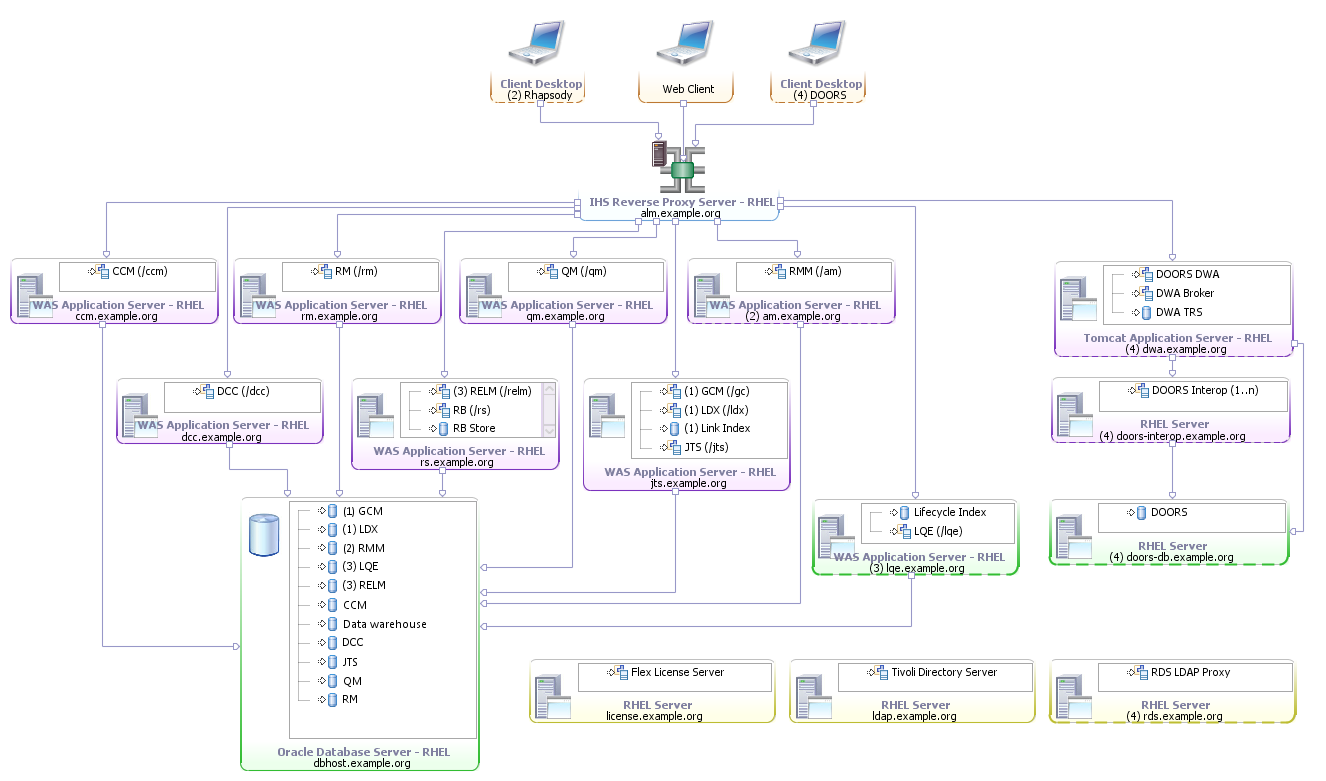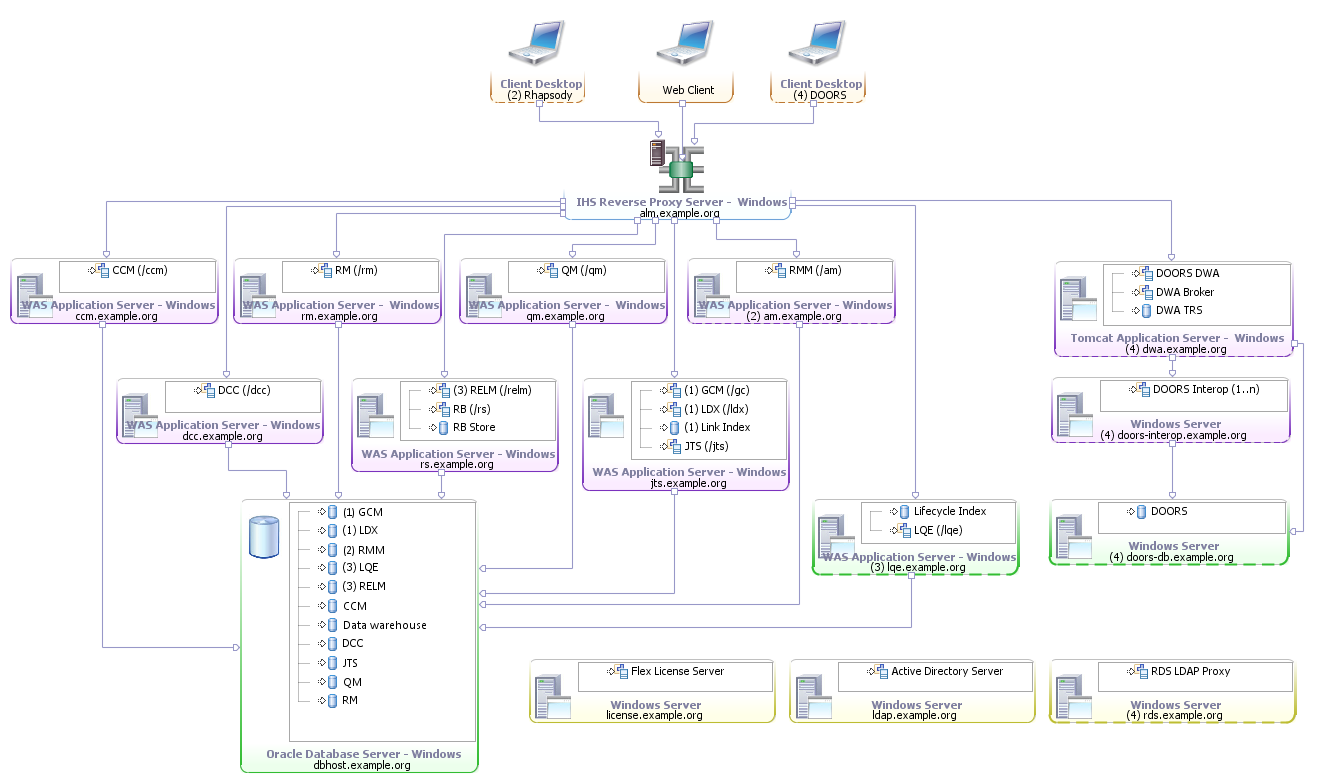r2 - 2015-07-02 - 17:03:13 - Main.dchadwickYou are here: TWiki >  Deployment Web > DeploymentPlanningAndDesign > RecommendedALMDeploymentTopologies6
Deployment Web > DeploymentPlanningAndDesign > RecommendedALMDeploymentTopologies6
Recommended Application Lifecycle Management (ALM) deployment topologies 6.0 
Authors: StevenBeard, DavidChadwick, ThomasPiccoli Build basis: CLM and SSE 6.0
Standard topologies overview
This page describes the Recommended ALM Deployment Topologies for version 6.x. Refer to Standard deployment topologies overview for high-level description of the standard topologies, how they are categorized and their key characteristics. These recommended deployment topologies for the Rational solution for Application Lifecycle Management (ALM) are a subset of the standard ALM deployment topologies. For the rest of the standard topologies, see alternative ALM deployment topologies (for version 6.x). Within this wiki, additional guidance and best practices will be developed about how to best instantiate these recommended topologies.Introduction and approach
These recommended topologies were chosen based on the following criteria:- Those that are most commonly and successfully deployed to date by customers and internally within IBM
- Those that are based upon the most commonly available platforms, operating systems and middleware
- Those that are based upon technologies that customers, partners and the IBM Rational Field have the most experience with
- Those that are the focus of testing within IBM Rational.
Recommended topologies
(ALM-E1) Enterprise - Distributed / Linux / DB2
This enterprise topology uses Linux for the server operating systems. It includes both DNG and DOORS/DWA as the RM applications. The applications are distributed across separate servers and WAS instances. A reverse proxy is used to ensure public URI stability. DB2 is used for the databases and is hosted on a separate server. Finally, licenses are served by a floating license server and Tivoli Directory Server provides the LDAP based user management, for all but DOORS/DWA, which uses Windows Active Directory Server.| Metadata Variable | Value |
| Operating System | Linux |
| Database Management System | DB2 |
| Application Server | WAS |
| License Management System | Floating |
| User Management System | Tivoli Directory Server |
| Other technologies | Reverse Proxy |
- ALM-E1 Topology Diagram for v6.x:

(ALM-E3) Enterprise - Distributed / Linux / Oracle
This enterprise topology uses Linux for the server operating systems. It includes both DNG and DOORS/DWA as the RM applications. The applications are distributed across separate servers and WAS instances. A reverse proxy is used to ensure public URI stability. Oracle is used for the databases and is hosted on a separate server. Finally, licenses are served by a floating license server and Tivoli Directory Server provides the LDAP based user management, for all but DOORS/DWA, which uses Windows Active Directory Server.| Metadata Variable | Value |
| Operating System | Linux |
| Database Management System | Oracle |
| Application Server | WAS |
| License Management System | Floating |
| User Management System | Tivoli Directory Server |
| Other technologies | Reverse Proxy |
- ALM-E3 Topology Diagram for v6.x:

(ALM-E7) Enterprise - Distributed / Windows / Oracle
This enterprise topology uses Windows for the server operating systems. It includes both DNG and DOORS/DWA as RM applications. The applications are distributed across separate servers and WAS instances. A reverse proxy is used to ensure public URI stability. Oracle is used for the databases and is hosted on a separate server. Finally, licenses are served by a floating license server and Windows Active Directory Server provides the LDAP based user management.| Metadata Variable | Value |
| Operating System | Microsoft Windows |
| Database Management System | Oracle |
| Application Server | WAS |
| License Management System | Floating |
| User Management System | Microsoft Active Directory Server |
| Other technologies | Reverse Proxy |
- ALM-E7 Topology Diagram for v6.x:

Related topics: Deployment web home
External links:
Additional contributors: IanCompton
| I | Attachment | Action | Size | Date | Who | Comment |
|---|---|---|---|---|---|---|
| |
alm_e1_rhel_db2.png | manage | 112.9 K | 2015-07-02 - 16:21 | UnknownUser | ALM-E1 Topology Diagram for v6.x |
| |
alm_e3_rhel_oracle.png | manage | 113.6 K | 2015-07-02 - 16:49 | UnknownUser | ALM-E3 Topology Diagram for v6.x |
| |
alm_e7_windows_oracle.png | manage | 117.7 K | 2015-07-02 - 16:59 | UnknownUser | ALM-E7 Topology Diagram for v6.x |
-
 Deployment web
Deployment web
-
 Planning and design
Planning and design
-
 Installing and upgrading
Installing and upgrading
-
 Migrating and evolving
Migrating and evolving
-
 Integrating
Integrating
-
 Administering
Administering
-
 Monitoring
Monitoring
-
 Troubleshooting
Troubleshooting
-
 To do
To do
-
 Under construction
Under construction
-
 New
New
-
 Updated
Updated
-
 Constant change
Constant change
- None - stable page
- Smaller versions of status icons for inline text:
-





Contributions are governed by our Terms of Use. Please read the following disclaimer.
Dashboards and work items are no longer publicly available, so some links may be invalid. We now provide similar information through other means. Learn more here.

